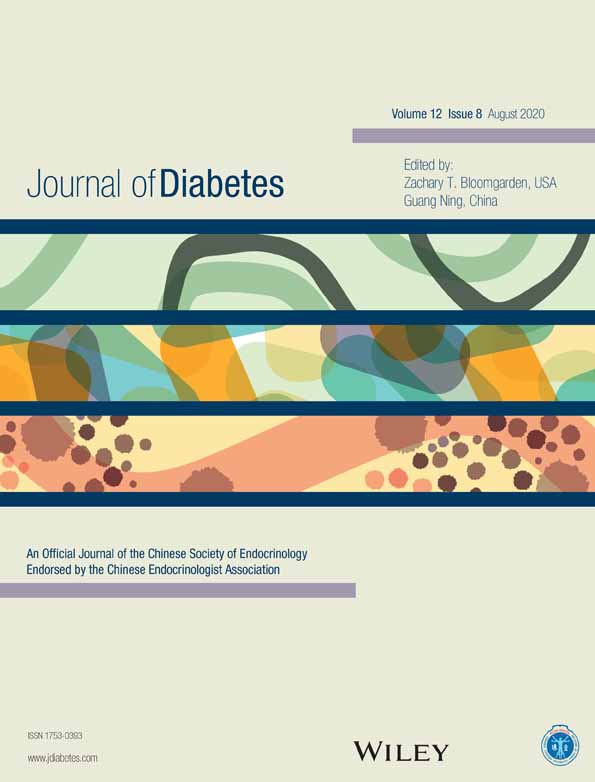Dose-response associations between serum creatinine and type 2 diabetes mellitus risk: A Chinese cohort study and meta-analysis of cohort studies
血肌酐和2型糖尿病风险之间的剂量反应关联:一项中国队列研究和基于队列研究的meta分析
Funding information: The Medical Research Foundation of Guangdong Province, Grant/Award Number: A2017181; The Nanshan Science and Technology Innovation Bureau, Grant/Award Number: 2017057; The National Natural Science Foundation of China, Grant/Award Number: 81373074, 81402752 and 81673260; The Natural Science Foundation of Guangdong Province, Grant/Award Number: 2017A030313452; The Sanming Project of Medicine in Shenzhen, Grant/Award Number: SZSM201803080; The Science and Technology Development Foundation of Shenzhen, Grant/Award Number: CYJ20140418091413562, JCYJ20160307155707264
Abstract
enBackground
This study aims to investigate the association between serum creatinine and risk of type 2 diabetes mellitus (T2DM) based on a cohort analysis and meta-analysis of cohort studies.
Methods
We enrolled 41 439 participants aged ≥18 years without T2DM at baseline, who had ≥2 health examinations based on an ongoing prospective cohort in Beijing. Cox proportional hazards regression model was used to estimate hazard ratios (HRs) and 95% CIs. For the meta-analysis, cohort studies reporting risk estimates for the serum creatinine-T2DM association were included. A random-effects model was used to calculate summary relative risks (RRs) and restricted cubic splines to model the dose-response association.
Results
During a mean follow-up of 3.54 years, 1867 developed T2DM. Low serum creatinine was associated with increased risk of T2DM; adjusted HRs (95% CIs) across sex-specific quartiles were 1.45 (1.24, 1.71), 1.19 (1.02, 1.39), 1.07 (0.92, 1.24), and 1.00 (reference). The association was significant for both sexes and individuals with overweight or obesity. In the meta-analysis of six cohort studies (including the current study) involving 115 767 participants and 5370 T2DM events, the pooled RR was 1.61 (95% CI 1.35, 1.92), comparing the lowest with the highest category of serum creatinine. We found a linear association between serum creatinine and T2DM risk (Pnonlinearity = .082) and an increased risk of T2DM with each 0.1-mg/dL decrease in serum creatinine (RR = 1.07; 95% CI 1.04, 1.09).
Conclusions
The cohort study and meta-analysis provide further evidence supporting the negative association between serum creatinine and T2DM risk in a linear dose-response pattern.
摘要
zh背景
本研究旨在通过队列研究和纳入队列研究的meta分析, 探讨血肌酐与2型糖尿病(Type 2 diabetes mellitus, T2DM)风险之间的关联。
方法
本研究纳入了41439名年龄≥18岁, 在基线时未患有T2DM, 且进行了2次以上健康体检在北京的参与者。采用Cox比例风险回归来估计风险比(hazard ratios, HRs)和95%置信区间(confidence intervals, CIs)。Meta分析纳入的研究为报道血肌酐与T2DM关联的风险估计的队列研究。采用随机效应模型估计相对危险度(Relative risk, RR), 限制性立方样图拟合剂量-反应关系。
结果
在平均3.54年的随访中, 有1867例T2DM新发病例。血肌酐过低明显增加了患T2DM的风险;性别特定的四分位数(Q1-Q4)的校正HR(95% CI)为1.45(1.24, 1.71), 1.19(1.02, 1.39), 1.07(0.92, 1.24)和1.00(参照组)。该关联在不同性别和超重/肥胖者中均显着相关。Meta分析共纳入6项队列研究(包括本研究), 共包含115,767名参与者和5,370例T2DM病例。将最低与最高的血肌酐水平进行比较, RR为1.61(95% CI 1.35, 1.92)。血肌酐和T2DM风险之间呈线性关联(Pnonlinearity = 0.082), 血肌酐每降低0.1 mg/dL, T2DM风险随之增加(RR = 1.07; 95% CI 1.04, 1.09)。
结论
本队列研究和meta分析提供了进一步的证据支持血肌酐和T2DM负相关关联, 且两者之间的剂量反应关系呈现线性趋势。
CONFLICT OF INTEREST
The authors declare that they have no competing interests.




